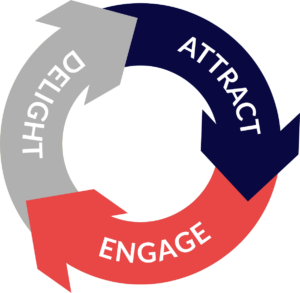The future of business success lies in the power of your customer data. A CRM is no longer just a basic requirement, it’s the cost of entry into this modern market. But it’s not just a tool, it’s a revolution.
A CRM is the key to unlocking a treasure trove of gold, waiting to be claimed. Your customer data is a goldmine, and it’s right there at your fingertips. It’s time to say goodbye to the mundane, and hello to the future. With a CRM, you can access, understand, and monetise this goldmine, turning it into a revenue-generating growth machine.
This is how to do it!
The Data Rush: A Treasure Hunt for Customer Insights
Data is nothing without purpose. It’s like a car without a driver, it’s simply taking up space. But when you collect, store, and harness your data in a smart and effective way, it becomes a valuable asset that requires minimal effort to maintain.

Think about it, having a list of names of people who have shown interest in your business is nice, but what about knowing who’s just browsing, who’s ready to buy, and who’s ready to buy AND critical for making a sale? That’s the power of understanding your data.
With smart data management, you can ensure that the right message reaches the right people at the right time, without any annoying or labour-intensive processes. The art of targeting has become so sophisticated, that ads are no longer intrusive, they’re informative. We’ve come so far that the quality of ads served in our Instagram feeds and YouTube videos is simply taken for granted. So, embrace the power of your data and let it work for you.
Outdated Methods are Obsolete
The game of digital marketing has changed, and it’s changed dramatically. Gone are the days of reckless data mining and disregarding privacy. Today, we live in a world where GDPR regulations and savvy prospects demand that we handle data with care. And even companies like Apple, who have redefined the game, have had a profound impact on the way we approach digital marketing. So, it’s time to step up and embrace the new era of digital marketing, one where privacy and respect for the customer are at the forefront.
Sound familiar?
| Buying data lists | Mass email sends with misspelt names | Cold calls without consent | Spam SMS messages from random numbers |
The world of digital marketing is plagued by a problem. The problem of outdated practices that only serve to harm our reputation and give us all a bad name. You know the ones I’m talking about, the data scraping, privacy invading tactics that have no place in modern marketing.
And yet, there are still companies out there relying on these outdated practices. It’s hard to believe, but it’s true. But why? Is it a lack of care or malicious intent? No, it’s often the opposite. It’s a lack of understanding the delicate balance of science and craft that makes great marketing.
You see, companies often forget they sit on a goldmine of customer data, rich with insights into behaviour, desires, and preferences. This is where the magic happens. Enter the Customer Relationship Management system, or CRM for short. A CRM is the system that holds all your customer data and when used correctly, it can drive revenue and delight prospects at every stage of the buying journey. From a simple spreadsheet to an AI-powered single source of truth, the possibilities are endless.

Maximising Your CRM for the Ultimate Customer Experience
The true revolutionaries in marketing today know the value of putting the customer at the forefront. The customer experience should be the driving force behind every decision a marketer makes.
That’s why HubSpot developed and popularised the flywheel model. When centred around the customer experience, marketing attracts and fuels sales. Sales engages and propels service. Service delights and fuels marketing. And it all starts with the foundation of a solid CRM system.

Your CRM holds the key to unlocking experience-driven marketing. It’s not just a buzzphrase, it’s your ticket to explosive growth. According to Forrester research, companies who prioritise the customer experience experience 40% faster growth and increase customer lifetime value by over 60%.
However, too many marketers still have disconnected tools and tactics, resulting in fragmented customer experiences, siloed data, and a lack of understanding of what’s actually working.
By integrating your martech stack with the CRM creates a seamless view of the customer experience for your team, enabling you to craft truly personalised experiences across all channels and accurately measure your marketing success.
HubSpot does this out the box, but it’s not the only choice out there and it is possible to roll your own solution using best-in-class tools if you have the technical capability.
Unlock the Power of Personalisation with CRM-Fueled Marketing
The quest for delivering a truly personalised experience is the key to capturing attention in today’s competitive landscape. With the help of your CRM, you can elevate your marketing game by tailoring content, offers, CTAs, and even your chat bot interactions to each individual visitor. Imagine a world where your website dynamically adjusts, highlighting content your visitor hasn’t seen yet, or where your chat bot greets them by name and knows which sales rep they’ve been working with. This is the power of CRM-driven marketing.
The Trifecta of CRM Triumph:
- Segment — Cater to your prospects’ unique requirements with customised messaging
- Contextualise — Clearly articulate the value proposition
- Personalise — Foster a sense of importance and affection through individualised attention.
Segment
Are you tired of being bombarded by irrelevant advertisements? With an average of 5,000–10,000 ads per day, it’s no wonder consumers are quickly tuning out. But there’s a bigger issue for marketers beyond just frustrated prospects — apathy.
When your customers don’t see the direct relevance of your messaging in their life, they’ll simply ignore it. Don’t let apathy be the downfall of your marketing efforts. With a CRM, you can understand your customers like never before and deliver the content they need, when they need it, in a way that works for them.
Unlock the power of personalised marketing with the data in your CRM. Isolate specific customer groups based on their wants, needs, and buying readiness to drive results and stand out in a crowded market. Say goodbye to the noise and hello to meaningful connections with your audience.

Leverage the Power of Lists for Targeted Marketing Efforts
If you have the ability to segment your database based on any data point you possess, you can wield a lot of power. Whether it’s based on a contact’s identity, company, or activity, segment lists allow you to tailor your marketing approach to different groups of customers.
For example, with a list of all contacts in the third month of their contract you can reach out with a personalised upsell offer that complements their current package. Similarly, you can target prospects who have visited your pricing page more than once in the past 30 days by sending them a special discount code.
By targeting each group with relevant messaging that addresses their specific needs, you’ll create a more impactful and personalised marketing experience for your customers.
Contextualise
The buying journey for every product or service goes through three crucial stages — Awareness, Consideration, and Decision. However, the duration of each stage varies based on the product or service.
While a person looking for a cold drink on a hot day will move from Awareness to Decision quickly, a Project Manager considering new forecasting software for a global Saas business may take months. Despite the differences in journey, there is a common denominator — consumers need tailored content specific to each buying stage to make a decision.
For example, before a Project Manager becomes aware of your forecasting software, they must first identify the pain caused by their current planning tools. With a problem in hand, they’ll then seek solutions, which can range from integrating new tools to outsourcing the entire issue.
Trigger campaigns based on the Buyer’s Journey
The content below has been created for buyers at each stage of their journey. By triggering emails and messages that are linked to the stage the prospect is in, you can ensure that the content is relevant to their needs. Consider the buyer’s perspective and determine what they need at each stage of their journey to make a purchase.
Awareness:
Blog: “Why Project Managers never have enough hours in the day”
Consideration:
Guide: “10 ways to become a more effective Project Manager”
Decision:
Case study: “Why company X chose our technology to solve their forecasting problem”
By labelling prospects in your CRM based on their customer journey, you can provide them with the appropriate messaging for their journey. Just as you wouldn’t propose marriage on a first date, you also don’t want to overwhelm a prospect with technical data when they have just discovered they have a problem. Instead, provide well-timed and useful pieces of information like breadcrumbs that guide the buyer in, rather than pushing your product too soon.
By segmenting your audience, you can provide them with relevant and contextually appropriate sales messaging to nurture prospects and increase conversion rates.
Leverage Dynamic Content for Targeted and Personalised Messaging
With the ability to deliver dynamic content, you can deliver customised experiences to your prospects and contacts by adjusting your emails, landing pages, and Calls To Action (CTAs) based on specific criteria. This way, you can present content that aligns with a prospect’s buying stage in their journey.
HubSpot implement this well using “Smart Content”. By using the data in your CRM, HubSpot Smart Content can display Awareness, Consideration, or Decision-related content for each prospect, helping you to provide contextually relevant information. This eliminates the need for manual work and ensures that your content is tailored to the buyer’s needs.
By making the most of dynamic content, you can deliver highly personalised experiences, improve conversion rates, and drive more revenue with less effort.
Personalise
Maximise Personalisation in Sales Messaging
Personalisation in today’s world is more than just addressing a prospect by name. It involves sending relevant and timely messages that resonate with the recipient in terms of language, tone, and subject matter.
For example, receiving an email greeting you by name may seem personalised, but it’s not enough if it’s just one of many similar automated emails received in a day. But if a HR software vendor sends a message specific to your HR management problem just before your renewal date, that’s effective personalisation. The same goes for a small business owner receiving a persuasive message about tax returns from an invoice management software vendor.
Personalisation makes prospects feel like the message is directed specifically to their needs at the right time, leading to better conversions. But there’s a fine line between personalisation and being overbearing, so it’s crucial to strike the right balance. Custom properties can help in gathering company-specific information on leads for a more tailored approach.
The key to effective personalisation is a combination of segmentation (knowing whom to speak to), contextualisation (what to say), and personalisation (how to say it). So ensure you gather data, understand your audience, and deliver personalised messages that drive conversions.
Your CRM is the driving force behind your growth
Maintaining the cleanliness and accessibility of your CRM data will lead to increased sales and satisfied customers.
By categorising your audience, you can precisely aim your messaging towards the correct group of prospects.
Adapting your messaging to fit a particular point in your prospect’s journey through the sales funnel will enhance conversions at every stage.
Personalising your communication approaches your prospects as individuals, fostering trust and admiration for your brand. Demonstrate to your prospects that they are important by recognising their challenges and providing valuable information and solutions when they need it most.
The CRM Triggers that Fuel Hyper-Personalised Communications
Having access to demographic data in your CRM is a valuable asset for personalising your communications, but incorporating activity and engagement data can take it to the next level by delivering highly targeted, timely messaging that truly resonates with your audience.
Communicate at the right time
- Personalise Recommendations with Page Tracking
Track individual contact’s page visits to provide customised recommendations that meet their needs, similar to email remarketing.
- Drive Sales with Customised Bots Based on Deal Stages
Use deal stages to activate bots on specific pages that are tailored to the buyer’s journey and answer their questions at the right time.
- Enhance Engagement with Timed Personal Messages
Send out personal messages such as birthday wishes, anniversary greetings, or renewal reminders using information gathered from known dates to engage with prospects and customers.
- Align with Buyers in Real Time with Workflow Delayed Actions
In workflows, delay actions until a contact has completed a specific action, such as visiting a web page or filling out a form. This enables you to align with buyers in real-time and send emails only when they are engaged with you.
Maximise the Potential of Your CRM as a Marketing Powerhouse
Transform your CRM into a marketing powerhouse by delivering personalised messages to the right audience at the optimal time. By evaluating and implementing tools that are fit for purpose, you can easily create highly personal and context-sensitive campaigns on a large scale, leading to increased revenue and sustainable cost savings.




